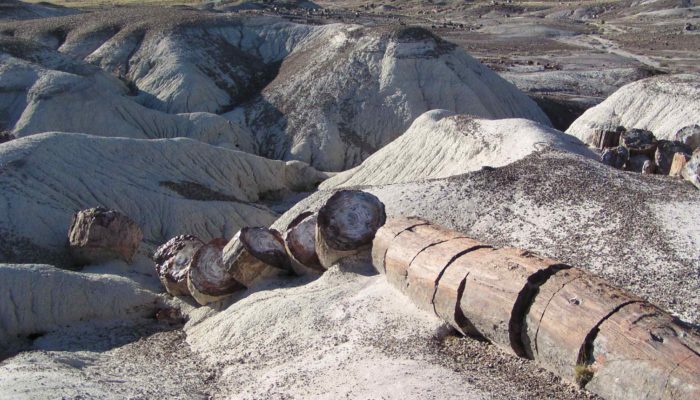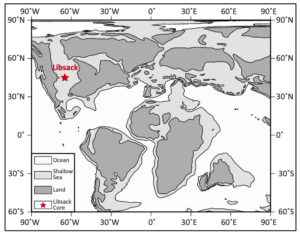
This year marks the 100th anniversary of Milutin Milankovitch’s first paper about Earth’s climate. Milankovitch argued that the amount of solar radiation Earth receives, and hence its climate, varies cyclically as its orbit changes due to gravitational tugs from the other planets. His climate theory fell into disrepute during the 1950’s but was rehabilitated in the 1970’s.
Today, many people are aware that cyclic changes in Earth’s orbit, now known as Milankovitch Cycles, repeatedly plunged Earth into and out of glacial episodes during the last 2.7 million years. Less well known, however, is the control those same cycles have exerted to form rhythmically oscillating sedimentary sequences throughout Earth history, thanks to the changes in depositional conditions they induce. Stratigraphers “tune” the chronology of a rhythmic rock sequence to Milankovitch Cycle beats and then anchor those beats to the geologic time scale using radiometric and paleomagnetic dates to produce an astrochronology. Such astrochronologies, because of their unusually high temporal resolution, provide profound insights into the evolution of Earth, its inhabitants, and the Earth-Moon system.
Milankovitch orbital cycles have four primary periods. Earth’s rotation axis precesses on an approximately 20 thousand year cycle and changes its tilt (called obliquity) on an approximately 40 thousand year cycle. Changing gravitational tugs from Jupiter and the inner planets cause our orbit’s eccentricity (the elliptical nature of our orbit) to oscillate in two modes, one approximately 100 thousand years and the other a steady 405 thousand years. The remarkable stability of the 405 thousand year cycle, which is modulated by Jupiter and Venus, makes it the Milankovitch Cycle of choice to construct astrochronologies.
The stratigraphy of the eastern USA’s Newark Basin allowed scientists to construct one important early example. This Triassic rift basin hosts rhythmically alternating lake and fluvial sediments that reflect lake expansion and shrinkage as the climate changed. Scientists tuned the Newark Basin astrochronology to the 405 thousand year Milankovitch Cycle and then tied it to the geologic time scale using magnetic polarity reversals and high-resolution radiometric dates from basalt interbedded with the uppermost sediment layers. Although the chronology’s high temporal resolution appeared to represent a big leap forward, some scientists worried about missing cycles due to unrecognized sedimentary hiatuses; they didn’t trust the astrochronology because it lacked a radiometric date to anchor the sequence’s base.
Clearly, a test of the Newark astrochronology’s accuracy was needed. The scientists had to find a comparably aged section that could be tied to radiometric dates at its top and bottom. In 2013, they found the ideal candidate: a 500-meter-long core drilled in the Chinle Formation of Arizona’s Petrified Forest National Park. This core possesses cyclic sequences deposited in rivers and lakes that drained a volcanically active area. The youngest detrital zircons in each sediment layer likely record that layer’s depositional age, so the scientists dated those zircons in key layers to provide radiometric pinpoints at the core’s top and bottom. The team then applied the same strategy to the Petrified Forest core as they had to the one from Newark Basin. By 2018, they had produced an identical astrochronology that confirms that no cycles are missing from the Newark Basin section and therefore “cements” its reliability.
The Petrified Forest/Newark Basin astrochronology has had many important implications. For example, paleontologists have long believed that the Late Triassic fossil record suggests dinosaurs achieved ecological dominance at mid-to-high latitudes millions of years before they achieved this in the tropics. This conclusion, however, has been controversial because of dating uncertainties. Application of the Petrified Forest/Newark Basin astrochronology to mid-latitude fossil sites in Argentina and Greenland, and to low-latitude sites in Canada’s Fundy Basin and Petrified Forest, now confirm the delay in tropical dinosaur dominance is real.

Palaeogeographic map for the Late Cretaceous (90 Myr ago; copyright 2015 Colorado Plateau Geosystems). The location of the Libsack core, which was used to construct the Niobrara astrochronology, is indicated with a red star.
A 2017 astrochronology for the Niobrara Formation provides another great example of the utility of high-precision astrochronologies. Astronomical models suggest that a fundamental resonance produced by the orbits of Earth and Mars, which creates the so-called ‘grand cycles’, switched at some time between 50-100 million years ago from a 1.2 million year period to the current 2.4 million year period, but because the switching time is sensitive to model assumptions, evidence from the rock record is the only way to pinpoint it. The Niobrara astrochronology revealed that the resonance switched at 85-87 million years ago, at the same time as something called ‘Oceanic Anoxic Event 3’. Oceanic Anoxic Event 3 is the most enigmatic of the Cretaceous Oceanic Anoxic Events; the Niobrara astrochronology suggests that orbital forcing of climate triggered this important biogeochemical event.
Another recent paper explored the evolution of the Earth-Moon system using Bayesian statistical inversion of a Mesoproterozoic astrochronology for rhythmically bedded black shale and chert in northeast China’s Xiammaling Formation. The study concluded that at 1.4 billion years ago, the distance from the Earth to the Moon was 340,900 km, compared to 384,400 km today, and a day was around 18 hours long. These values corroborate model calculations and have important implications for understanding how tidal dissipation has slowed Earth’s rotation rate.
Astronomical models robustly confirm the metronomic character of the 405 thousand year Milankovitch Cycle only back to 50 million years ago. Empirical confirmation from the Petrified Forest astrochronology that the cycle is unchanged back to 215 million years ago now makes it possible to create a complete Mesozoic-Cenozoic astrochronology, and maybe one for the entire Phanerozoic. Advances based on Milankovitch’s insight 100 years ago have now brought us to the cusp of creating a higher precision geologic time scale that will continue to revolutionize our understanding of cause and effect for many key Earth and solar system events.





Denis-Didier Rousseau
Just a short comment: This year is not the 100th anniversary of Milankovich’s first “paper”, but of the book ““Théorie Mathématique des Phénomènes Thermiques Produits par la Radiation Solaire” which English translation should read “Mathematical Theory of Celestial Phenomena Caused by Sunrays”, 339 pages, pubished in 1920 by the Academie Yougoslave des Sciences et des Arts de Zagreb , and edited by Gauthier-Villars Company in Paris.
For more details please read “Milutin Milankovic 1879-1958” from M. Milankovic’s autobiography published in 1995 by the European Geophysical Society, one of EGU parents, under André Berger editorship.